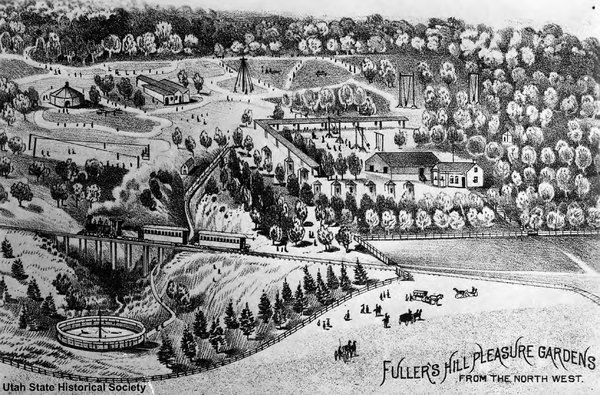Dublin Core
Title
Description
As Salt Lake City and the rest of the U.S. industrialized in the late 19th century, life was changing rapidly. Growing cities presented bad smells and extreme pollution. One way Americans coped with the reality of urbanization was the creation of the pleasure resort. Branded as a way to return to nature and pastoral fantasy, pleasure resorts were a distinctly urban phenomenon. Fuller’s Hill, located east of downtown Salt Lake City, was one such place now lost to history.
Started in 1875 on the slope just west of what is today the University of Utah, Fuller’s Hill boasted a gorgeous view overlooking Salt Lake Valley for those who chose to visit for only ten cents. It had constant entertainment, including games both familiar and obscure. One newspaper advertised “sack-racing, grab-log, dipping for oranges, Copenhagen, stilt racing… croquet, and so forth.” It promised a “strong whirligig for the juveniles, an archery ground and bows and arrows,” and of course, “pretty and romantic arbors” to promenade through. Perhaps its most famous attraction was the camera obscura -- a large room with a pinhole viewfinder that allowed visitors to see images projected onto a wall. The first ever in Utah, the camera obscura was a predecessor to other entertainment like movies. Ads for Fuller's Hill also boasted “the collection of curiosities… and the monster devil fish.” Apparently a kind of octopus, some visitors offered to buy the “devil fish” because it was such a large specimen, but the park decided to keep it for themselves along with their camera obscura, whirligigs, and ice cream saloon.
People trolleyed up to Fuller’s Hill for practically any occasion -- for Scottish immigrant celebrations, school trips, firefighter’s reunions, and even Queen Victoria’s birthday. After receiving special permission from the Salt Lake mayor to have fireworks there, visitors also went for Independence Day. But eventually urbanization and population growth caught up to Fuller’s Hill. Its magnificent -- and supposedly safe -- swing rides and ziplines gave way to the urbanization it was trying to escape.
Creator
Source
______________
See John S. McCormick, “Resorts,” Utah History Encyclopedia, accessed October 2022; Randy Astle, “Early Mormonism and the Magic Lantern View,” June 28, 2018 Dawning of a Brighter Day: Twenty-First Century Mormon Literature, accessed October 2022; “Fuller’s Hill Gardens,” May 13, 1883, Salt Lake Herald-Republican; “A Pleasure Resort,” April 25, 1880, Salt Lake Tribune; “Fuller’s Hill,” April 30, 1876, Salt Lake Herald-Republican; “Fuller’s Hill,” July 4, 1875, Salt Lake Herald-Republican; “Fuller’s Hill,” July 23, 1875, Salt Lake Herald-Republican; “Fuller’s Hill,” June 13, 1875, Salt Lake Herald-Republican; “Caledonian Reunion,” July 13, 1877, Salt Lake Herald-Republican; “Victoria’s Birthday,” May 25, 1875, Salt Lake Herald-Republican; “Fuller's Hill Gardens,” May 29, 1886, Salt Lake Herald-Republican.

